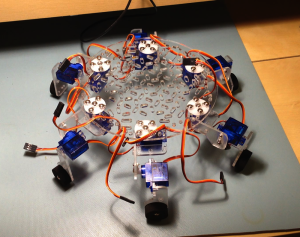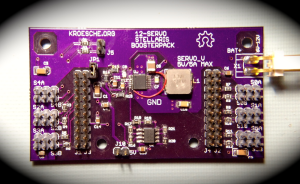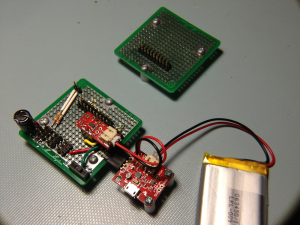A co-worker made me aware of a relatively inexpensive hexapod kit from Sparkfun. I have always liked hexapods and wanted to try working on one myself but all the kits I found seemed ridiculously expensive to me. So when I found out about this one I bought one on a whim. I needed a way to control it and of course I wanted to use the Stellaris microcontroller since I worked on that team. Since we had just recently introduced the Stellaris LaunchPad, I decided to make my own BoosterPack to control the 12 servos needed for the hexapod.
Here is a picture of the hexapod kit that I bought from Sparkfun:
Assembled 12-servo hexapod from Sparkfun
You can buy a controller board to go with it, but I thought it would be more interesting to make my own controller. Since I worked (until recently) at TI, I wanted to use a Stellaris microcontroller. TI had just recently come out with the Stellaris LaunchPad so I thought that was a logical choice for the controller. The LM4F microcontroller on the LaunchPad is actually a very good choice for controlling 12 servos because it has timers that are perfect for generating the servo control waveforms. The LM4F has 6 wide timers. The wide timers are 64 bit timers that can be split into 32-bit half timers. This means you can get 12 32-bit timers giving you plenty of timing resolution needed to generate the 20 ms PWM signal needed for hobby servos.
I started off with some naive ideas about how to power the servos. I built a prototype using a LiPo battery and a power supply board I got from Sparkfun. As you can see in the photo, I provided a hookup for two servos and started testing with that. This arrangement was not even close to being able to supply even one moving servo without browning out.
I thought about powering the servos directly from a battery pack. But the servos need 5-6V and from what I have seen by reading about hobby servos, you should not exceed 6V. So, I could stack up some normal alkaline batteries to get 6V but I wanted to use rechargeable lithium polymer batteries and these cells are not a convenient voltage to achieve 5-6V.
So I decided I needed a power supply circuit. The best I could tell from web searches and some crude attempts at measuring the current I decided these small servos needed 100-200 mA when moving. I decided that a 5A supply should be sufficient. I also decided on 5V (instead of 6V) because then I could use the same power supply to provide 5V to the LaunchPad.
I also chose to use a 2S LiPo battery (instead of 1S or 3S). I wish I could say I did some analysis to decide on this but it was really arbitrary. A 2S pack will provide a range from 6-9V from fully drained to fully charged. A 3S will be about 12V fully charged. So I chose 6-12V as the input range for the power supply. I used TI’s power supply design tool to come up with the power supply circuit.
Now that I know I will have a battery, I thought it would be handy if the microcontroller could read the battery voltage. So I added an op-amp circuit that will translate the battery voltage (6-9V) into a range suitable for input to the Stellaris ADC (0-3.3V).
To summarize, here are the features:
- connectors for 12 hobby servos
- servo connectors provide 5V, ground, and wide timer signal to each servo
- 5V/5A switching power supply
- 6-12V battery input
- 6-9V battery measuring circuit
Here is what the finished and assembled board looks like:
Fully Assembled Servo BoosterPack
You might notice some jumper wires on the board. I had two mistakes in the power supply circuit. I have since corrected those in the board design files.
There area couple of other changes I might make in the future.
- add a switch to turn it off and on (right now you have to plug/unplug the battery
- use a different battery connector
I use Eagle to create the schematic and lay out the board. I had the board made at OSH Park, where I got 3 boards for $25 in a little less than 2 weeks. I don’t have any experience with other board makers like BatchPCB, but the process at OSH Park is so smooth and they make the boards in USA so I would definitely use OSH Park in the future.
I placed all the design files, including the BOM info on github at https://github.com/kroesche/lp-servo12.
I also put a servo driver at https://github.com/kroesche/stellaris_drivers
I wrote some test code and some simply tripod gait code, but at the time of the this writing it was not suitable for posting. Once I clean it up I will add it to the github as well.
Finally, here is a video I made about my BoosterPack.


Comments
There are no comments yet.